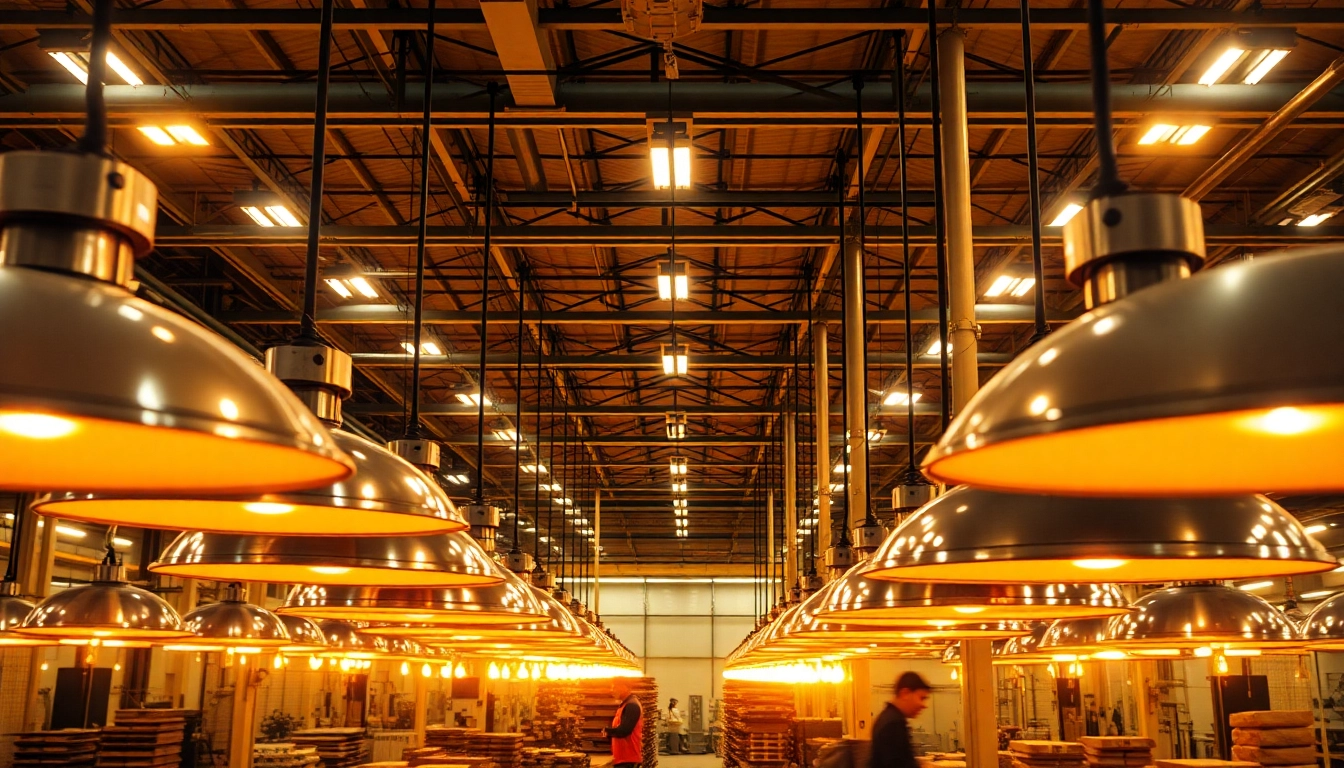
Understanding Industrial Heat Lamps
What Are Industrial Heat Lamps?
Industrial heat lamps are specialized heating devices designed for a variety of thermal applications in different settings, including manufacturing facilities, automotive industries, and printing processes. These lamps utilize infrared (IR) radiation to provide heat directly to objects and surfaces, rather than heating the air around them. This direct approach to heating ensures a faster and more efficient thermal transfer, making industrial heat lamps essential tools in today’s fast-paced industrial environment. By focusing infrared energy specifically where it is needed, these lamps contribute significantly to productivity and efficiency across various sectors.
How They Work: The Technology Behind Heating
The technology behind industrial heat lamps leverages the principles of infrared radiation. Unlike traditional heating methods, which rely on convection (heating the air) or conduction (heating through contact), infrared heaters produce radiant heat that directly warms surfaces and materials. This is achieved through quartz infrared emitters, which are designed to convert electrical energy into radiant heat. The result is an efficient system that minimizes heat loss and maximizes energy use.
For example, at Huai’an Yinfrared Heating Technology, our proprietary manufacturing techniques, including patented gold reflectors and ceramic white coatings, enhance the efficiency and target heating capabilities of our quartz IR emitters. This innovation leads to higher heating efficiency and reduced thermal losses, making our industrial heat lamps a step ahead for various applications.
Types of Industrial Heat Lamps
Industrial heat lamps come in various forms, each designed for specific tasks and heat requirements:
1. Short Wave Infrared Lamps: These lamps emit infrared radiation at shorter wavelengths, leading to fast heating times. They are ideal for applications requiring rapid heat-up, such as drying paint, inks, and coatings.
2. Medium Wave Infrared Lamps: With a balance between rapid heat output and deeper surface penetration, medium wave lamps are perfect for general-purpose heating. They find extensive applications in the automotive industry for curing and drying processes.
3. Long Wave Infrared Lamps: These emitters provide longer wavelengths of infrared radiation, ideal for applications where gentle and uniform heating is required, such as in food processing or for heating large surfaces without scorching.
Each type of lamp has its own unique advantages and applications, making it crucial for businesses to select the appropriate type based on their specific heating needs.
Energy Efficiency of Industrial Heat Lamps
Comparing Energy Costs: IR vs. Traditional Heating
In an era where energy efficiency is paramount, the comparison of running costs between infrared heating systems and traditional heating methods is becoming increasingly relevant. Traditional heating processes can be inefficient, often leading to lost energy in the form of heat escaping into the environment. In contrast, industrial heat lamps can achieve up to 96% energy conversion. This means that nearly all the energy consumed is directly converted into heat, significantly reducing operational costs over time.
For industries that operate on tight margins, the cost savings from using energy-efficient heat lamps can lead to substantial financial benefits, contributing to the overall bottom line.
Achieving 96% Energy Conversion
Achieving high energy conversion rates is one of the critical advantages of using infrared heat lamps. The efficient design of quartz IR emitters, complemented by their innovative reflective technologies, allows businesses to optimize their heating processes. For instance, our patented gold reflectors at Huai’an Yinfrared Heating Technology enhance radiative heat transfer, ensuring more heat reaches the target area without significant losses along the way.
This high energy efficiency not only minimizes energy consumption but also aids in reducing the environmental impact of industrial operations. As companies become more eco-conscious, integrating energy-efficient solutions becomes vital for sustainability and meeting regulatory compliance concerning energy use and emissions.
Reducing Fuel Costs: Real-World Examples
Numerous industries have reported significant reductions in fuel costs through the adoption of industrial heat lamps. For example, an automotive component manufacturer switched from conventional heating methods to infrared heating systems and documented fuel savings of approximately 30% within the first year of implementation.
Similarly, a printing business that integrated infrared ink-drying lamps found that it could decrease its electricity bill by around 25% while simultaneously improving drying times and product quality. These case studies highlight how industrial heat lamps can transform operational efficiency and cost-effectiveness, leading to a healthier financial outlook for businesses.
Applications of Industrial Heat Lamps
Automotive and Manufacturing Solutions
In the automotive industry, heat lamps play a crucial role in various processes, including drying paint and curing adhesives. The ability to produce localized heat allows for quicker turnaround times and improved finish quality, essential in a sector that thrives on speed and precision.
Manufacturing facilities also benefit greatly from infrared heating technology. Operations ranging from plastic curing to food processing utilize heat lamps to achieve efficient heating without compromising product integrity. The versatility of heat lamps means they can suit a vast array of manufacturing applications effectively.
Comfort Heating in Commercial Spaces
Beyond industrial applications, infrared heat lamps are increasingly being used in commercial spaces such as restaurants and retail environments. These lamps can offer localized heating, enhancing customer comfort without heating entire buildings. The targeted warmth improves the dining experience while also conserving energy, making it a win-win for business owners aiming to reduce operational costs and promote customer satisfaction.
Ink-Drying Applications in Printing
In the world of printing, the speed and quality of the drying process are paramount. Infrared heat lamps serve as an excellent solution for ink-drying applications, offering quick drying times without smudging or other quality issues often associated with traditional methods. By using infrared technology, print businesses can streamline their production processes while ensuring high-quality outputs that keep customers satisfied and returning for more.
The Advantages of Infrared Heating Technology
Faster Drying Times and Higher Efficiency
One of the standout benefits of infrared heating technology is the speed at which drying occurs. Conventional methods can take several minutes to heat an entire surface, while infrared heat lamps provide immediate warmth to the area in need, drastically reducing drying times. This rapid heating capability allows industries to streamline their processes, reduce downtime, and elevate overall efficiency.
The enhanced drying speed does not come at the cost of quality. In fact, with infrared heating, companies can achieve better results in finish quality due to consistent and even heating throughout. This advantage can help businesses maintain competitive edges in demanding markets.
Targeted Heating: The Gold Reflector Advantage
At Huai’an Yinfrared Heating Technology, our unique patented gold reflector technology significantly improves the efficiency of our infrared lamps. This advanced design channels heat directly toward the target area, minimizing energy waste and maximizing thermal output. The backed reflector strategy ensures that users gain the most benefit from their infrared heaters, resulting in targeted heating solutions that can be adjusted according to specific needs.
By adopting infrared lamps equipped with this cutting-edge technology, businesses can thrive even in competitive spaces where operational efficiency plays a crucial role in success.
Long-Term Cost Savings for Businesses
Investing in industrial heat lamps represents a strategic choice for businesses looking to enhance their operational efficiency. The initial investment in infrared heating technology is quickly offset by long-term savings on fuel and maintenance costs. Businesses that choose infrared solutions often report higher productivity due to quicker drying times and reduced downtime thanks to uniform heating.
Over time, these cost benefits accumulate, leading to substantial savings that can be reinvested into other areas of the business or used to enhance overall competitiveness.
Choosing the Right Industrial Heat Lamp
Factors to Consider When Selecting Heat Lamps
Selecting the appropriate industrial heat lamp requires careful consideration of several key factors:
1. Application Requirements: Understand the specific application needs, including the materials being heated and the desired outcomes.
2. Space and Environment: Assess the operating environment—larger spaces may require different configurations compared to smaller, confined areas.
3. Energy Efficiency: Prioritize energy-efficient models to reduce operating costs and minimize environmental impact.
4. Cost: While upfront costs are important, consider the long-term savings in energy and maintenance.
By addressing these factors, businesses can ensure they select the most suitable industrial heat lamps to meet their unique heating demands.
Custom Fixtures and Controls Explained
Many manufacturers, including Huai’an Yinfrared Heating Technology, offer custom fixtures and control systems to enhance the functionality of infrared heating setups. These tailor-made solutions help optimize heating performance and ensure that lamps operate effectively in varying environments.
Custom fixtures make installations more efficient and can be adjusted based on the specific requirements of each application. Advanced control systems also enable users to manage heating cycles and energy consumption more effectively, further boosting the overall operational efficiency of the heating systems.
Future Trends in Industrial Heating Technology
The industrial heating technology landscape is evolving rapidly, driven by innovations that enhance energy efficiency, adaptability, and performance. As industries seek to optimize their operations further, the move toward advanced infrared heating solutions is certain to grow.
Future trends may include integrating IoT technology for smart heating solutions that adjust automatically based on conditions, further enhancing energy savings and efficiency. Additionally, research into new materials for heat lamp construction could lead to even more efficient heating systems, ensuring that infrared heating remains at the forefront of industrial heating technology.





